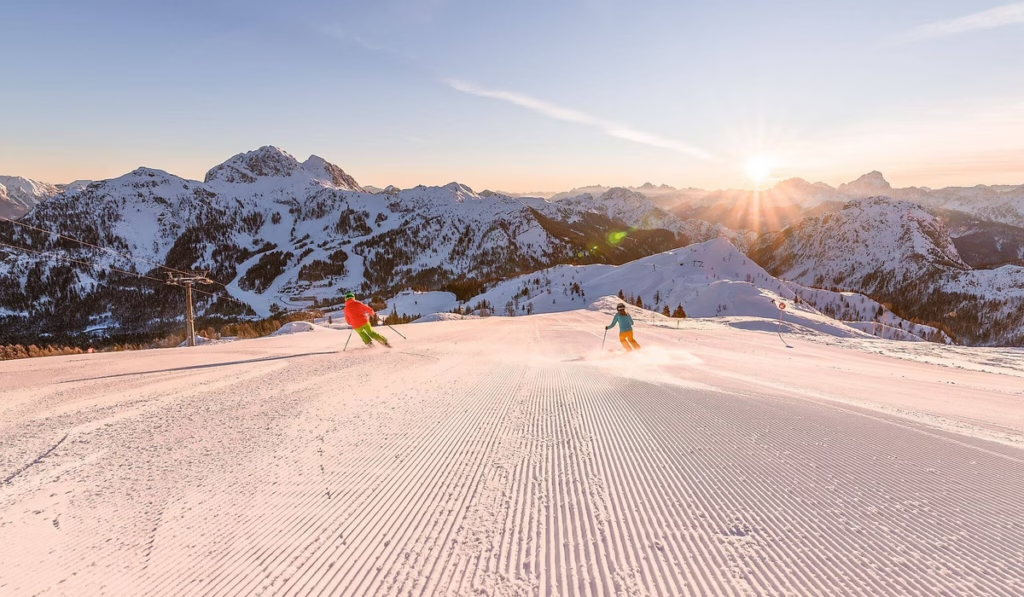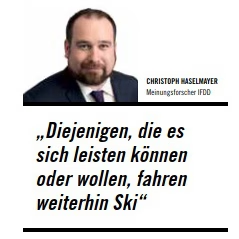A representative exclusive survey commissioned by Ski Guide Austria shows: Austrians still enjoy skiing despite rising prices, but are more hesitant about taking a classic winter holiday.

The debate surrounding rising ski ticket prices resurfaces every year: The question of whether skiing has become unaffordable for families with children or low-income individuals is particularly contentious. Since the €80 mark for day tickets was broken for the first time this season, it's clear that the vast majority of Austrians – 85 percent – view skiing as a luxury sport that only the wealthy can afford. This is the result of a representative survey of 1,500 Austrians aged 16 and over, conducted by the Institute for Demoscopy & Data Analysis (IFDD) for the Ski Guide Austria. The survey also aimed to clarify the actual state of skiing despite this perception, what challenges the industry faces, and what new offerings businesses and regions should develop to ensure this leisure activity, so vital to the Austrian economy, continues to have a successful future.
The most important point first: As sobering as the 85 percent figure (even 87 percent among those under 30) may seem at first glance, it's put into perspective upon closer inspection. After all, 42 percent of those surveyed participate in a snow sport. Among those under 30, this figure rises to 56 percent; only among those over 50 is it a meager 36 percent. Also interesting: Snow sports apparently fascinate more men (47 percent) than women (37 percent). When it comes to the type of snow sport, skiing is the undisputed number one with 89 percent – for both women and men. This also applies to snowboarding (15 percent), which is particularly popular among those under 30 (32 percent) – while men slightly outnumber women in cross-country skiing (18 percent) and ski touring (17 percent). Freeriding (3 percent), on the other hand, is apparently predominantly a male domain.

The industry can also take heart from the fact that 42 percent of snow sports enthusiasts pursue their hobby at least regularly (1-2 weeks), frequently, or very frequently (more than 3 weeks per year). A further 55 percent do so at least for a few days at a time. For IFDD head Christoph Haselmayr, these figures mean that skiing remains part of everyday culture despite all the discussions about rising costs: "Of course, 80 euros is subjectively expensive. But those who can afford it or want to continue skiing. And at least 12 percent explicitly do not see it as a luxury." Ultimately, the decision is also a matter of personal priorities: Although skiing in Austria is still relatively inexpensive compared to other countries, one could easily spend the money for a week's ski vacation in the Austrian mountains.
They also plan to take a winter holiday in a warm-water destination. The perception of prices is certainly "significant," according to the pollster. Accordingly, only 10 percent of Austrians are currently planning a ski or winter holiday. Even though 77 percent of Austria's winter tourism depends on foreign visitors, this 10 percent figure is still concerning: After all, 14 percent of those surveyed planned a winter holiday last year. It's hardly surprising that among those without ski holiday plans, 65 percent find alternatives such as long-distance or city breaks, wellness or beach holidays more attractive in winter – a percentage that is also higher than last year.
Those who still plan a traditional winter holiday at home do so primarily for skiing (64 percent), want to spend time with family and friends (23 percent), enjoy wellness and relaxation (4 percent), cross-country skiing (4 percent), or winter hiking (3 percent). The much-discussed and highly praised après-ski scene, even among foreign visitors, now plays a minor role: it's a main motivation for only 2 percent – and almost exclusively for men. And even then, this is largely true for those under 30.
44 percent say they want to save on ancillary expenses such as restaurants and mountain huts, while 52 percent do not. This is positive insofar as the figures were noticeably worse two years ago – the propensity to save among those who continue to go on ski holidays has therefore decreased. Nevertheless, only 14 percent rate the value for money of a winter holiday as very good or good; 32 percent as average. For 47 percent, it is poor or very poor. Countermeasures are needed here if the cable car companies and tourism businesses don't want to lose even more domestic skiers and winter holidaymakers in the long run. Of course, there are also numerous small ski resorts with affordable rates, about which you can read more in the 2026 edition of the Ski Guide Austria, as well as promotional offers from the industry giants. However, the IFDD head believes that "the ski resorts and municipalities are called upon to do even more in this direction and ensure that there are enough affordable offers for families and locals." This is enormously important, if only to secure the next generation of skiers.
Travel to winter holidays remains car-centric: 90 percent arrive by car, 10 percent by public transport. Only among those under 30 is the figure lower, at 24 percent. This makes sense: For families with children and lots of luggage, traveling by car is still much easier and more relaxed; a young single person without children is more likely to opt for the train and/or bus. Haselmayer: "The widely promoted use of public transport is more of a wish expressed by certain political groups, which is, however, very difficult to implement."„
Snow reliability is definitely a must-have issue: 40 percent of the total population (including non-skiers) consider artificial snowmaking very or quite important for the industry, apparently for clear economic reasons. "White ribbons" (snow ribbons) are not entirely convincing overall – also when considering the total population – yet 21 percent would still go on winter holidays even with predominantly artificially snow-covered slopes. Opinions are divided on dynamic pricing, which is increasingly being used in many ski resorts: 39 percent find it generally good, 35 percent bad. And of the 20 percent who have already had experience with it, only 38 percent report positive experiences, while 55 percent report negative ones. There is clearly still room for improvement regarding transparency of offers and prices. And last but not least, quite positive for Austria's winter tourism: despite the climate debate, 55 percent still consider skiing to be relevant today.
In summary, a broad but price-sensitive core market is emerging: car-oriented, focused on clear offers and simple planning, with high expectations for transparent pricing, tangible added value on-site, and credible snow reliability. Those who deliver on these points will score points in the coming seasons, according to IFDD head Haselmayer.